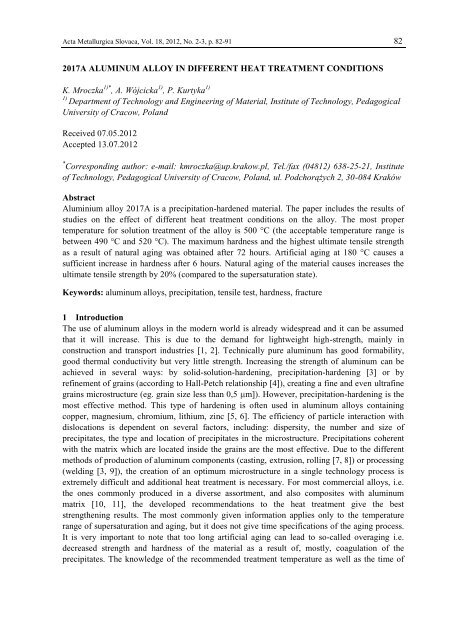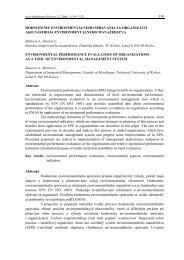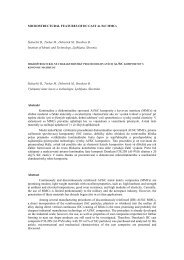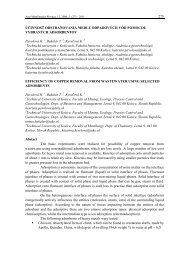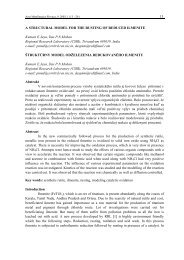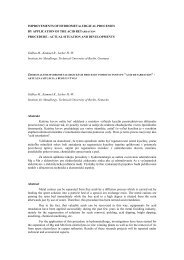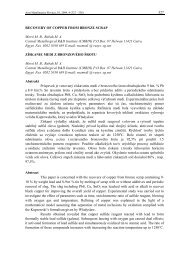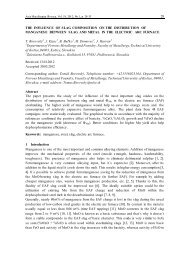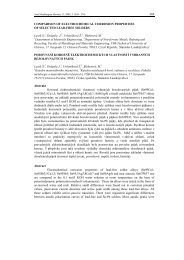82 2017A ALUMINUM ALLOY IN DIFFERENT HEAT TREATMENT ...
82 2017A ALUMINUM ALLOY IN DIFFERENT HEAT TREATMENT ...
82 2017A ALUMINUM ALLOY IN DIFFERENT HEAT TREATMENT ...
- No tags were found...
Create successful ePaper yourself
Turn your PDF publications into a flip-book with our unique Google optimized e-Paper software.
Acta Metallurgica Slovaca, Vol. 18, 2012, No. 2-3, p. <strong>82</strong>-91 <strong>82</strong><strong>2017A</strong> <strong>ALUM<strong>IN</strong>UM</strong> <strong>ALLOY</strong> <strong>IN</strong> <strong>DIFFERENT</strong> <strong>HEAT</strong> <strong>TREATMENT</strong> CONDITIONSK. Mroczka 1)* , A. Wójcicka 1) , P. Kurtyka 1)1)Department of Technology and Engineering of Material, Institute of Technology, PedagogicalUniversity of Cracow, PolandReceived 07.05.2012Accepted 13.07.2012* Corresponding author: e-mail: kmroczka@up.krakow.pl, Tel./fax (04812) 638-25-21, Instituteof Technology, Pedagogical University of Cracow, Poland, ul. Podchorążych 2, 30-084 KrakówAbstractAluminium alloy <strong>2017A</strong> is a precipitation-hardened material. The paper includes the results ofstudies on the effect of different heat treatment conditions on the alloy. The most propertemperature for solution treatment of the alloy is 500 °C (the acceptable temperature range isbetween 490 °C and 520 °C). The maximum hardness and the highest ultimate tensile strengthas a result of natural aging was obtained after 72 hours. Artificial aging at 180 °C causes asufficient increase in hardness after 6 hours. Natural aging of the material causes increases theultimate tensile strength by 20% (compared to the supersaturation state).Keywords: aluminum alloys, precipitation, tensile test, hardness, fracture1 IntroductionThe use of aluminum alloys in the modern world is already widespread and it can be assumedthat it will increase. This is due to the demand for lightweight high-strength, mainly inconstruction and transport industries [1, 2]. Technically pure aluminum has good formability,good thermal conductivity but very little strength. Increasing the strength of aluminum can beachieved in several ways: by solid-solution-hardening, precipitation-hardening [3] or byrefinement of grains (according to Hall-Petch relationship [4]), creating a fine and even ultrafinegrains microstructure (eg. grain size less than 0,5 m]). However, precipitation-hardening is themost effective method. This type of hardening is often used in aluminum alloys containingcopper, magnesium, chromium, lithium, zinc [5, 6]. The efficiency of particle interaction withdislocations is dependent on several factors, including: dispersity, the number and size ofprecipitates, the type and location of precipitates in the microstructure. Precipitations coherentwith the matrix which are located inside the grains are the most effective. Due to the differentmethods of production of aluminum components (casting, extrusion, rolling [7, 8]) or processing(welding [3, 9]), the creation of an optimum microstructure in a single technology process isextremely difficult and additional heat treatment is necessary. For most commercial alloys, i.e.the ones commonly produced in a diverse assortment, and also composites with aluminummatrix [10, 11], the developed recommendations to the heat treatment give the beststrengthening results. The most commonly given information applies only to the temperaturerange of supersaturation and aging, but it does not give time specifications of the aging process.It is very important to note that too long artificial aging can lead to so-called overaging i.e.decreased strength and hardness of the material as a result of, mostly, coagulation of theprecipitates. The knowledge of the recommended treatment temperature as well as the time of
Acta Metallurgica Slovaca, Vol. 18, 2012, No. 2-3, p. <strong>82</strong>-91 83this process are essential for optimum hardening results. With regard to the ranges of the heattreatment temperature, deviations from specified ranges and the impact of the implementation oftreatment at a slightly higher or slightly lower temperature should be known. This is importantdue to the industrial and even the laboratory practice because one has to take into account e.g.:thermal inertia of the furnace - temperature drop after the introduction into the furnace of amaterial of greater weight and overheated above the set point temperature, when the control ofthe furnace is trying to rapidly increase the temperature to a specified value.The aim of the study whose results are presented below was to determine the effect of differentsupersaturation temperatures and aging on the strengthening of aluminum alloy <strong>2017A</strong>.2 Material and experimental methodsThe studied material is aluminum alloy EN AW-<strong>2017A</strong> (PN-EN: 573-3:2009). This aluminumalloy is used for plastic working. The main alloying addition is copper and therefore the alloy isclassified within the group of 2XXX series alloys. The chemical composition of the materialpresented in table 1 while table 2 shows the mechanical properties respectively.Designation of aluminum alloy EN AW-<strong>2017A</strong> according to other standards (counterparts) [12]:Designation with respect to chemical symbols according to BS EN: 573-3:AlCu4MgSi(A)Designation according to PN-79/H-<strong>82</strong>160:PA6Designation according to D<strong>IN</strong>: AlCuMg1Werkstoff No.: 3.1325Table 1 The chemical composition of the material - alloy EN AW-<strong>2017A</strong>Cu Mg Mn Si Fe Zn Cr3.9 0.6 0.6 0.4 0.7 0.25 0.1Table 2 The mechanical properties of alloy EN AW-<strong>2017A</strong> - for a specific state of treatmentState R p0,2 [MPa] R m [MPa] A5 [%] Hardness [HV]0 70 180 13 – 20 50T4 230 - 275 380 - 425 10 – 21 115T6 250 400 10 130State:0 – annealed – for products obtained with specified properties after hot-productionT4 – heat treated – supersaturated and naturally aged to a stable stateT6 – heat treated – supersaturated and then artificially aged.In order to determine the effect of heat treatment parameters of the material on the mechanicalproperties the following experiments and tests were performed:supersaturation samples from different temperatures between 470 and 530 °C, then cooledin water,natural aging of supersaturated samples at temperatures from 470 to 530 °Cartificial aging of samples at temperatures of 140, 160, 180 °C which were supersaturatedof 500 °C /water,strength testing (static tensile test),hardness testing,
Acta Metallurgica Slovaca, Vol. 18, 2012, No. 2-3, p. <strong>82</strong>-91 84studies of the microstructure of fractures of selected samples broken in the static tensiletest,studies of the microstructure (light microscopy) of selected samples.The sheet of 6 mm thick of aluminum alloy <strong>2017A</strong>-T6, industrially produced was used in thestudies. Samples with dimensions of 20 x 20 mm were cut out.Heat treatment (supersaturation and artificial aging) was performed by heating the samples in alaboratory chamber furnace with digital control. Hardness measurement was carried out usingVickers method, with the load of 10 kG (10 kG = 98.07 N). Prior to the hardness measurement,the samples were subjected to grinding, in order to remove oxide layers formed during the heattreatment.Static tensile test were performed on a testing machine <strong>IN</strong>STRON TT-DM 10T with digitalcontrol. Testing samples with dimensions of l 0 = 20 mm, l = 57 mm, d = 4 mm were cut outfrom the sheet in the direction parallel to the direction of rolling, according to the standard roundsamples. The samples were mounted axially in the chuck and were stretched with traverse speedof V t = 0,01 mm/s. Under the adopted parameters of the sample, strain rate was:1l0Vt1200.010.00051s(1.)Tensile tests were conducted at ambient temperature.A microscopic examination was performed on fracture by scanning using the electronmicroscope SEM Philips M525. All the samples underwent fructure in the static tensile test. Themicrostructure examination was performed using the Olympus GX51 light microscope equippedwith Nomarski contrast and software for archiving and imaging analysis. The preparation of thesamples for observation consisted of metallographic specimens on the surface (of the sheet) andthe cross-section. The samples were grinded and polished mechanically. Disclosure of themicrostructure was obtained in two ways: by etching in HF+HNO 3 +H 2 O and by etching in anaqueous solution of NaOH (a concentration of which was chosen experimentally by etching thesamples sequentially with solutions, whose concentration was increased by adding to theexisting solution a few grams of NaOH).3 Results and discussionThe results of hardness measurements of the samples after supersaturation at temperature of470, 480, 490, 500, 510, 520 and 530 °C are presented in Fig. 1 in the form of a black line.Analysis of these results shows relatively small differences in hardness of the individual samplesfrom 89 ÷ 109 HV10. The highest hardness was obtained for the sample supersaturated at480 °C (109 HV10). The samples treated with the temperature in the range from 490 °C to510 °C have reduced hardness of about 98 HV10, which explains the temperature scope cited inthe literature (the range of supersaturation temperature 500 ÷ 510 °C [12,13]).Graphs in Fig. 1 also show the results of the hardness measurements of these samples (aftersupersaturation at the temperature ranging from 470 °C to 530 °C) made after 24, 48, 72 hours,the average of the measurements after 96 and 120 hours and after 62 days of the supersaturation(the aging temperature of about 20 °C). After 24 hours from the time of supersaturation of thesamples an increase in hardness from 17 HV10 to 36 HV10 (on average of 26 HV10) isobserved. Subsequent measurements made after 48 and 72 hours show a lower rate of increase in
Acta Metallurgica Slovaca, Vol. 18, 2012, No. 2-3, p. <strong>82</strong>-91 85hardness in relation to the first 24 hours. The resulting hardness is comparable, but the greatestwas obtained after 72 hours. Data analysis showed that supersaturation of the material at 500 °Ccauses an increase in hardness to a maximum value of 144 HV10. However, it can be noted thatsupersaturation in the temperature range between 490 °C and 520 °C results in similar hardnessof the material as the one obtained after aging for over 48 hours. It is therefore a greatertemperature range than the one recommended in the literature (500 – 510 °C [12]). The influenceof a long-term natural aging process (62 days) on hardness of supersaturated samples ispresented in Fig. 2. One can note that the results for samples supersaturated at the temperature of490 °C and higher are similar (about 130 HV10).Fig. 1 The results of hardness measurements made at different times of the natural aging ofthe supersaturated samples from the temperature range between 470 and 530 °C(average – average of measurement results at 96, 120 hours and 62 days)Fig. 2 The results of hardness measurements made after 62 days of natural aging ofsupersaturated samples from the temperatures range between 470 and 530 °CAs a complement to the above analysis, the results of the measurements are presented in a formgraph in Fig. 3. The highest hardness was designated in red; keep in mind that the chart is basedon data for each temperature and time. One can only assume that the values between the datapoints vary roughly in proportion.
Acta Metallurgica Slovaca, Vol. 18, 2012, No. 2-3, p. <strong>82</strong>-91 86Additionally, next samples supersaturated at 500 and 530 C were examined after less than 24hours – the results Fig. 1 (mark x). Results of the supersaturated sample at 500 C showed thatthe increase in hardness on about 20 HV10 was observed already after six hours of the naturalaging process. The remaining results are similar to those previously obtained. An analysis of theresults for the supersaturated sample at temperature of 530 C shows the same hardness(120HV10) after 6 hours of natural aging but a larger increase in hardness as hardness of thematerial after supersaturation was about 10 HV lower (89.2 HV10). For other times of aging(like for sample 500 C), the results are similar to previously described studies.Fig. 3 Summary results of hardness measurements made at different times of the naturalaging supersaturated samples at the temperatures between 470 °C and 530 °CArtificial aging was performed at temperatures of 140, 160 and 180 °C on samplessupersaturated from 500 °C (water cooling). Hardness tests were performed on samplessequentially removed from the furnace after the aging time of: 1, 2, 4, 6, 8, 10, 13, 16, 20, 26,32, 40, 48, 56, 64 hours. The measurement results are shown in Fig. 4.In the case of all the three aging temperatures, the increase in hardness of the material has beenobserved, while for the samples ageing at temperature 140 C and 160 C the increase in hardnessis slower and heterogeneous – after about 8 hours a decrease in hardness of the samples followedby the re-growth has been observed (Fig. 4). The fastest increase in the hardness is observed forthe sample aged at the temperature of 180 C, which can be explained by the most intensediffusion due to high temperature. The highest hardness, which however was reached after arelatively long time (52 hours), is obtained in the sample aged at the temperature of 160 C.Further studies show that in the case of the eight-hour aging process (technologically aging timewhich is frequently used), the process temperature should be 180 C because by applying this
Acta Metallurgica Slovaca, Vol. 18, 2012, No. 2-3, p. <strong>82</strong>-91 87temperature and after the specified time the achieved hardness is comparable to the hardnessachieved during a treatment process lasting longer. It can be also stated that for this temperatureof the aging the sufficient time to obtain the correct hardness is 6 hours.Fig. 4 The results of hardness measurements of samples artificially agedFig. 5 shows collective results for tensile samples in the initial states, after supersaturation, afternatural aging and after artificial aging. The analysis of the curves demonstrates a similar way offlow of the material and the strengthening of all samples except the artificially aged ones. Thecurve for this sample shows much less plasticity. As expected, the greatest plasticity and thelowest proof stress and tensile strength were shown by the sample in the state aftersupersaturation. The material in this state should be mostly a supersaturated solution without anysignificant amount of strengthening precipitates, but it is solution-strengthened. An excess ofFig. 5 Graphs stress-strain dependence (obtained in static tensile test), for the material instate: baseline, after supersaturation, after natural aging and after artificial agingcopper, which is present in the solution of aluminum will increase stresses in the crystal latticealuminum, which impede the movement of dislocations during plastic deformation. This kind ofconsolidation is much less effective than strengthening precipitation with secreting phase from a
Acta Metallurgica Slovaca, Vol. 18, 2012, No. 2-3, p. <strong>82</strong>-91 88supersaturated solution. The effects of such precipitation hardening (finely dispersed phasespontaneously forming from a supersaturated solution) are shown for a sample in naturally agedspecimens, whose strength (R p0,2 – 270 MPa, R m – 449 MPa) is much greater than in case of thesample in the supersaturated state (Fig. 5, Table 3). Comparison of curves of the samples atinitial and after natural aging showed a very similar shape, although the sample after naturalaging has greater strength and greater ductility. This is in line with the expectations because theinitial material is in the T6 condition, i.e. after artificial aging. However, we failed to obtainfrom the manufacturer of sheet metal information on the exact parameters of heat treatment ofthe material during the process of its production. The results of strength tests are summarized inTable 3. The results obtained for the endurance (strength) tests correlate with the results ofhardness testing of samples in each state.Table 3 The obtained results of strength tests of samples in different stateSamples state R 0,2 [MPa] R m [MPa] R u [MPa] A [%] Z [%]initial 250 436 622 22 39after supersaturation 150 374 596 28 44after natural aging 270 449 680 24 41after artificial aging 361 431 609 13 41Ru– actual stress in the breaking sampleThe analysis was performed using a scanning electron microscope (SEM). Fig. 6 showsexamples of areas of the sample in the state after supersaturation. The tensile curve for thissample shows the plasticity of this material but to a limited extent. This is confirmed byobservations of the fractures, where one can see the effects of plastic deformation mainly inmicroareas (Fig. 6a).Relative comparison of the analyzed surface with the results of samples observation in the initialstate indicates participation of smaller number of particles in the process of cracking (which canbe observed in fracture) which is in line with expectations, since the sample is in thesupersaturated state. Evaluation of chemical composition of particles on the basis of thecharacteristic X-ray spectrum of the EDS detector indicates brittle particles of -Al x Mn y Fe z type(for example: Al 2 FeMn 3 or Al 6 (MnFe)) and dissolved copper (Fig. 6a). In addition, the presenceof particles rich in aluminum and copper (probably phase Al 2 Cu) is noted (Fig. 6b). Thisindicates that the supersaturation process did not cause complete dissolution of the largerparticles containing copper. This condition may result from an insufficiently long time ofannealing of the sample above the solvus temperature (about 60 minutes). One must rememberthat the dissolution rate of particles is associated with the diffusion rate of released atoms fromthe particles, in this case copper, in the matrix, i.e. in the aluminum lattice. The fact thatdiffusion occurs not in pure aluminum, but only in the Al-Cu solution also contributes to theslowing down of the process. Copper comes from nanometric strengthening precipitates earlierdissolved in the matrix. Additionally, a few particles involving aluminum and magnesium werealso observed at the fractures. Moreover, the effects of plastic deformation in the form of socalledcraters (Fig. 6a – top of the photo) or surfaces on which slip bands are visible, are notedaround several particles (Fig. 6a – marked by the arrow). It can be assumed that these areas arelikely grain boundaries, which were deformed during tension with the disclosed slip bands ontheir surfaces. In general, the observed fracture can be described as ductile but not as much as isobserved in materials with high plasticity, such as Cu [14].
Acta Metallurgica Slovaca, Vol. 18, 2012, No. 2-3, p. <strong>82</strong>-91 89Observations of breakthroughs in the states of the initial and after aging lead to similarconclusions as above, except that a larger number of segregations in the breakthroughs wasobserved.Fig. 6 SEM micrograph of the fracture of the tensile tested sample after supersaturation: a)typical ductile fracture with brittle precipitation contain Al, Fe, Mn surrounded byslip bands marked by the arrow, b) precipitation contain Al, CuMicrostructure of the alloy (light microscopy), in the so-called delivery status (T6) of materiali.e. without any additional heat treatment (supersaturation, aging) were analyzed. In Fig. 7, thesurface microstructure disclosed by etching with NaOH-based solution is shown. An analysis ofthe microstructure shows the presence of precipitates of different size (above 1 m). These arethe segregations of different types, which can be determined on the basis of color that has beenobtained by etching and the light beam of light microscope. Differentiation of the phases is evenmore apparent when the observation is made in the interference-differential contrast byNomarski (Fig. 7). However, identification of the phase is not possible using this researchtechnique, though it appears that there will be mainly Al x Fe y Mn z –type precipitates which arecommonly found in aluminum alloys and larger precipitates of the phase occurring in the series2XXX alloys (Al 2 Cu [15] or S’ Al 2 CuMg [16], previously mentioned in the description ofresearch fractures. Smaller precipitates are also located at grain boundaries.Fig. 7 The microstructure (light microscopy - Nomarski contrast) of the parent material(initial state) etched NaOH: a) on the plate surface, b) on the cross-sectionThe analysis of the microstructure on the cross-section confirms the above observation andindicates strips layout of the segregations inside the materials which is typical for rolled items.Moreover, in Fig. 7b (observation in differential – interference contrast) one of the areas clearly
Acta Metallurgica Slovaca, Vol. 18, 2012, No. 2-3, p. <strong>82</strong>-91 90distinguishable against the background of the material matrix. This appearance of themicrostructure is likely the result of the characteristic crystallographic orientation occurring inthis area as compared to other grains due to the different intensity of etch reagent impact.Fig. 8 The microstructure (light microscopy) of the parent material (initial state) etchedHF+HNO 3 : a) on the plate surface, b) on the cross-sectionIn Fig. 8, the microstructure of the above described samples analyzed on the surface and crosssection,however etched with solution based on HF and HNO 3 , is shown. Observations confirmthe previously-given descriptions, i.e. the ones about the occurrence of different phases in thematerial, however the phase visible earlier as fair now changed its color to dark due to theprocess of digestion. This method of etching allowed to the explicit disclosure of the precipitateslocated at grain boundaries (Fig. 8a). Moreover, banding of the microstructure is visible better,which concerns not only the larger precipitates (Fig. 8b).4 ConclusionsOn the basis of experiments and studies the following conclusions are formulated:The temperature range for the process of supersaturation is 490 ÷ 520 C, the optimumtemperature: 500 C;The highest hardness of the material (144 HV10) after the natural aging process has beenobtained for quenched sample after solution annealing at 500 C, which has been aged for72 hours;The greatest increase in hardness (up to 146 HV10) as a result of the artificial agingprocess occurs when the temperature is 160 C, but only after 48-hour annealing;The fastest growth in hardness (max. hardness (142 HV10) after 20 hours the ofannealing) occurred in the material aged at temperature of 180 C;For the typical time of treatment of artificial aging (8 hours), the greatest increment inhardness was obtained in the material aged at temperature of 180 C (137 HV10);The highest tensile strength (449 MPa) and the greatest breaking stress of material (680MPa) was obtained for the material naturally aged; proof stress of the material is 270MPa;The material artificially aged at the optimal parameters (180 C / 8 hours) shows similartensile strength as the material in the initial state (431 MPa), but much higher proof stress(361 MPa);The smallest tensile strength (374 MPa), proof stress (150 MPa) and the greatest plasticity(28%) of the material are obtained in the state after supersaturation.
Acta Metallurgica Slovaca, Vol. 18, 2012, No. 2-3, p. <strong>82</strong>-91 91References[1] A. Francesconi, D. Pavarin, C. Giacomuzzo, F. Angrilli: International Journal of ImpactEngineering, Vol. 33, 2006, No. 1-12, p. 264-272[2] J. J. M. de Rijck, J. J. Homan, J. Schijve, R. Benedictus: International Journal of Fatigue,Vol. 29, 2007, No. 12, p. 2208-2218[3] Y. S. Sato, S. H. C. Park, H. Kokawa: Metallurgical and Materials Transactions A, Vol.32a, 2001, No. 12, p. 3033-3042[4] Y. D. Huang, Y. L. Liu, P. Wambua: Journal of Materials Science, Vol. 36, 2001, No. 19,4711-4717[5] M. K. Banerjee: Journal of Materials Science, Vol. 32, 1997, No. 24, p. 6645-6651[6] B. C. Wei, C. Q. Chen, Z. Huang, Y. G. Hang: Materials Science and Engineering A, Vol.280, 2000, No.1, p. 161-167[7] M. S. Kaiser, S. Datta, A. Roychowdhury, M. K. Banerjee: Materials Characterization, Vol.59, 2008, No. 11, p. 1661-1666[8] J. S. Robinson, T. Y. Liu, A. K. Khan, M. J. Pomeroy: Journal of Materials ProcessingTechnology, Vol. 209, 2009, No. 6, p. 3069-3078[9] K. Mroczka, A. Pietras: Archives of Material Science and Engineering, vol. 40, 2009, No. 2,p. 104-109[10] P. Kurtyka, Y-C. Yoo, S. Wierzbiński: Proc. of IV th Int. Conf. Non- Ferrus Metals andAlloys, Cracow, Poland, 1999[11] P. Kurtyka, M. Faryna, S. Wierzbiński: Composites, 2002, No. 4, p. 185-190[12] L. A. Dobrzański et al.: Dictionary of material science. Metals, polymers, ceramics andcomposites. Verlag Dashofer, Warsaw, 2006 (in Polish)[13] G. P. Dolan, J. S. Robinson: Journal of Materials Processing Technology, Vol. 153-154,2004, p. 346-351[14] A. Kováčová, T. Kvačkaj, M. Kvačkaj, T. Donič, M. Martikán, M. Besterci: ActaMetallurgica Slovaca, Vol. 15, 2009, No. 2, p. 100-104[15] B. Kuźnicka: Materials Characterization, Vol. 60, 2009, No. 9, p. 1008-1013[16] E. Dryzek, J. Dryzek: Tribology International, Vol. 39, 2006, No. 7, p. 669-677


